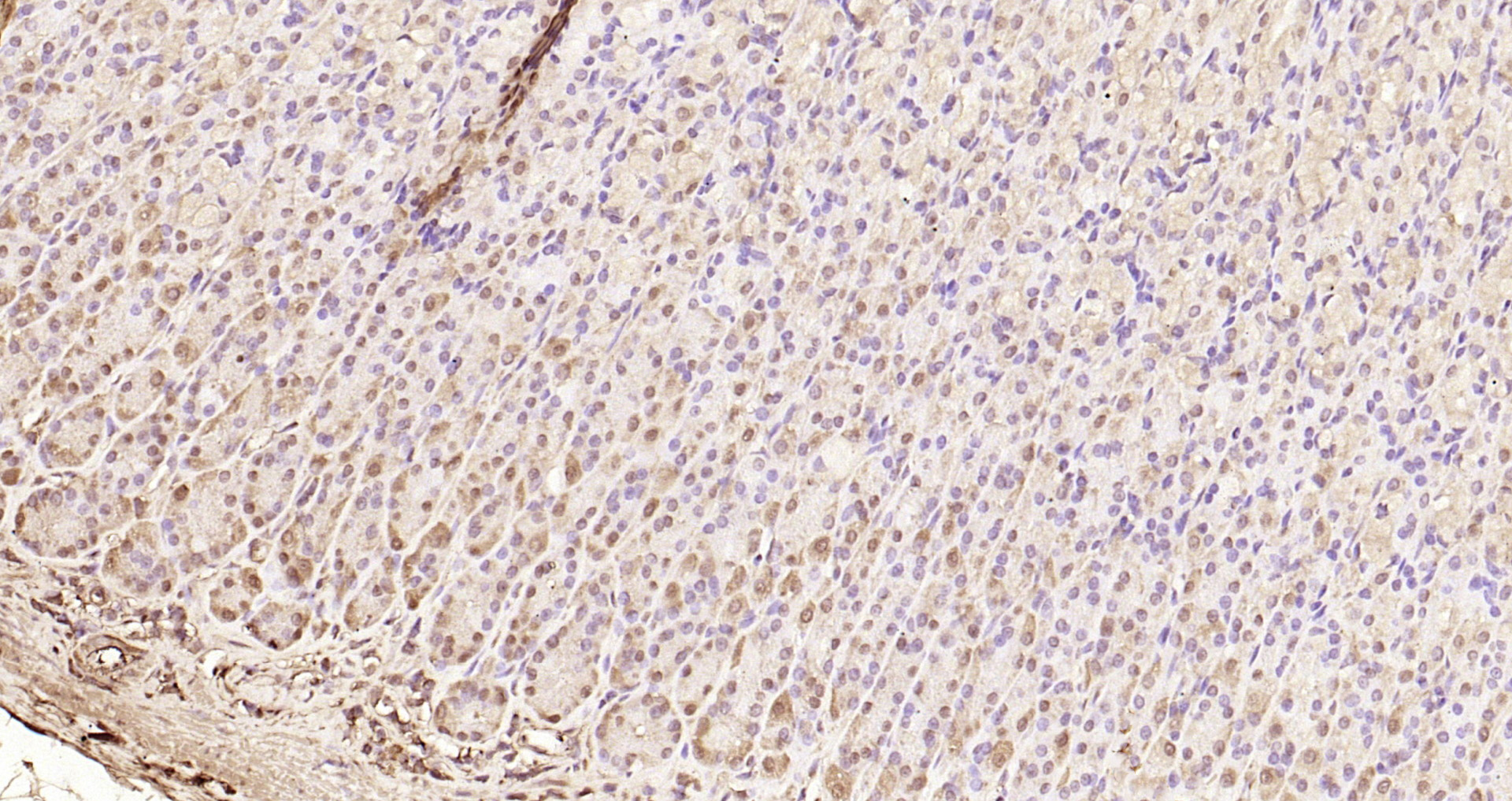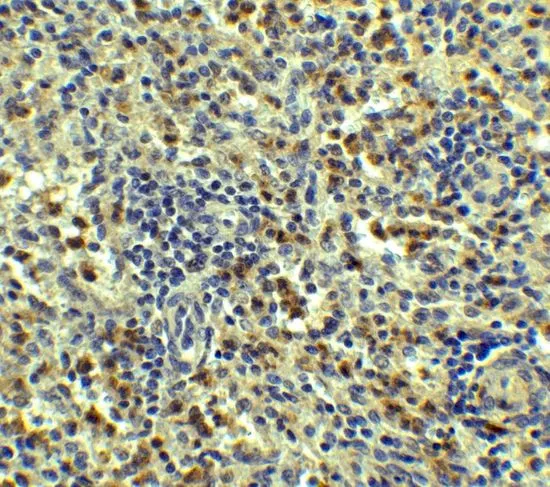SQSTM1 / P62 antibody [N3C1], Internal
GTX100685
ApplicationsFlow Cytometry, ImmunoFluorescence, ImmunoPrecipitation, Western Blot, ImmunoCytoChemistry, ImmunoHistoChemistry, ImmunoHistoChemistry Paraffin, Other Application
Product group Antibodies
TargetSQSTM1
Overview
- SupplierGeneTex
- Product NameSQSTM1 / P62 antibody [N3C1], Internal
- Delivery Days Customer9
- Application Supplier NoteWB: 1:500-1:3000. ICC/IF: 1:100-1:1000. IHC-P: 1:100-1:1000. FACS: 1:50-1:200. IP: 1:100-1:500. *Optimal dilutions/concentrations should be determined by the researcher.Not tested in other applications.
- ApplicationsFlow Cytometry, ImmunoFluorescence, ImmunoPrecipitation, Western Blot, ImmunoCytoChemistry, ImmunoHistoChemistry, ImmunoHistoChemistry Paraffin, Other Application
- CertificationResearch Use Only
- ClonalityPolyclonal
- Concentration0.39 mg/ml
- ConjugateUnconjugated
- Gene ID8878
- Target nameSQSTM1
- Target descriptionsequestosome 1
- Target synonymsA170, DMRV, EBIAP, FTDALS3, NADGP, OSIL, PDB3, ZIP3, p60, p62, p62B, sequestosome-1, EBI3-associated protein of 60 kDa, EBI3-associated protein p60, autophagy receptor p62, oxidative stress induced like, phosphotyrosine independent ligand for the Lck SH2 domain p62, phosphotyrosine-independent ligand for the Lck SH2 domain of 62 kDa, ubiquitin-binding protein p62
- HostRabbit
- IsotypeIgG
- Protein IDQ13501
- Protein NameSequestosome-1
- Scientific DescriptionThis gene encodes a multifunctional protein that binds ubiquitin and regulates activation of the nuclear factor kappa-B (NF-kB) signaling pathway. The protein functions as a scaffolding/adaptor protein in concert with TNF receptor-associated factor 6 to mediate activation of NF-kB in response to upstream signals. Alternatively spliced transcript variants encoding either the same or different isoforms have been identified for this gene. Mutations in this gene result in sporadic and familial Paget disease of bone. [provided by RefSeq]
- Storage Instruction-20°C or -80°C,2°C to 8°C
- UNSPSC12352203
References
- Duan C, Hou L, Deng X, et al. Fucose ameliorates the proinflammatory property of Fusobacterium nucleatum in colitis via altering its metabolism. Front Cell Infect Microbiol. 2023,13:1190602. doi: 10.3389/fcimb.2023.1190602Read this paper
- Hong X, Hsieh MT, Tseng TY, et al. Diarylheptanoid 35d overcomes EGFR TKI resistance by inducing hsp70-mediated lysosomal degradation of EGFR in EGFR-mutant lung adenocarcinoma. J Biol Chem. 2023,299(6):104814. doi: 10.1016/j.jbc.2023.104814Read this paper
- Hwang TI, Cuiu YC, Chen YC, et al. Tumor suppressive functions of hsa‑miR‑34a on cell cycle, migration and protective autophagy in bladder cancer. Int J Oncol. 2023,62(5):pii: 66. doi: 10.3892/ijo.2023.5514.Read this paper
- Jiang B, Feng L, Yang T, et al. Combination of chloroquine diphosphate and salidroside induces human liver cell apoptosis via regulation of mitochondrial dysfunction and autophagy. Mol Med Rep. 2023,27(2):pii: 37. doi: 10.3892/mmr.2022.12924.Read this paper
- Cui Y, Guo H, Zhang Q, et al. The combination of high glucose and LPS induces autophagy in bovine kidney epithelial cells via the Notch3/mTOR signaling pathway. BMC Vet Res. 2022,18(1):307. doi: 10.1186/s12917-022-03395-1Read this paper
- Mostafa DK, Nayel OA, Abdulmalek S, et al. Modulation of autophagy, apoptosis and oxidative stress: a clue for repurposing metformin in photoaging. Inflammopharmacology. 2022,30(6):2521-2535. doi: 10.1007/s10787-022-01041-8Read this paper
- Guo Y, Chomiak AA, Hong Y, et al. Histone H2A ubiquitination resulting from Brap loss of function connects multiple aging hallmarks and accelerates neurodegeneration. iScience. 2022,25(7):104519. doi: 10.1016/j.isci.2022.104519Read this paper
- Cui Y, Fang J, Guo H, et al. Notch3-Mediated mTOR Signaling Pathway Is Involved in High Glucose-Induced Autophagy in Bovine Kidney Epithelial Cells. Molecules. 2022,27(10). doi: 10.3390/molecules27103121Read this paper
- Pan M, Yin Y, Hu T, et al. UXT attenuates the CGAS-STING1 signaling by targeting STING1 for autophagic degradation. Autophagy. 2023,19(2):440-456. doi: 10.1080/15548627.2022.2076192Read this paper
- Kao CH, Su TY, Huang WS, et al. TFEB- and TFE3-dependent autophagy activation supports cancer proliferation in the absence of centrosomes. Autophagy. 2022,18(12):2830-2850. doi: 10.1080/15548627.2022.2051880Read this paper




![ICC/IF analysis of PFA-fixed HeLa cells using GTX00955 SQSTM1 / P62 antibody [GT1193]. Orange : Primary antibody Blue : DAPI Dilution : 1:100](https://www.genetex.com/upload/website/prouct_img/normal/GTX00955/GTX00955_20200327_ICC-IF_26_w_23053121_109.webp)
